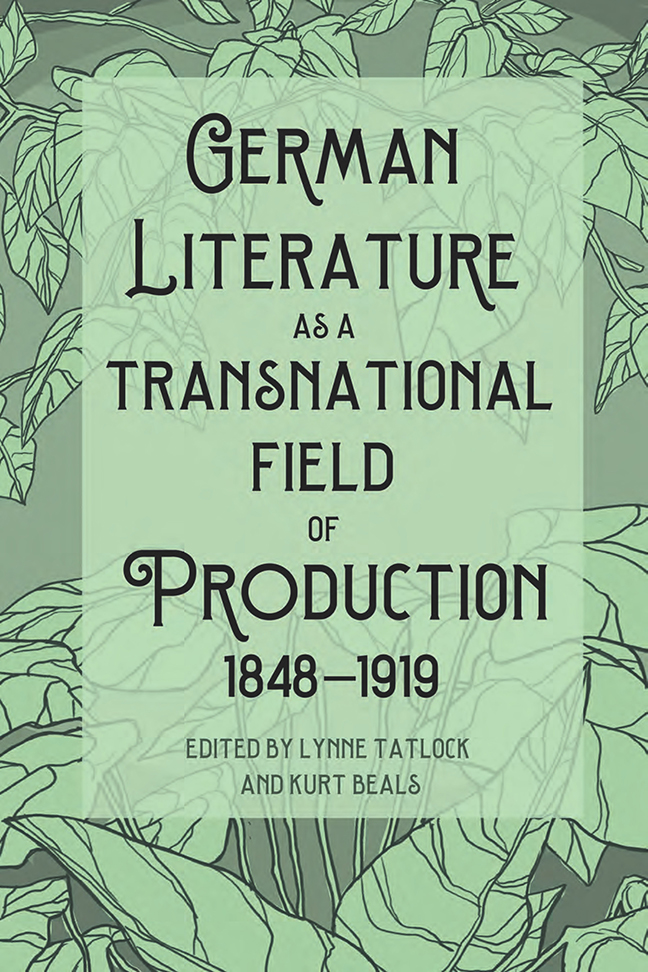Book contents
- Frontmatter
- Contents
- Acknowledgments
- Introduction: A Transnational Literary Field in the Age of Nationalism
- 1 The Passion of Johannes Scherr: Historiography as Trauma
- 2 Between Integration and Differentiation: On the Relationship between German and Austrian Literature in the Second Half of the Nineteenth Century
- 3 Reading Stifter in America
- 4 Travel Writing and Transnational Marketing: How Ida Pfeiffer brought the World to Austria and Beyond
- 5 Ernst Brausewetter's Meisternovellen Deutscher Frauen (1897–98): Gender, Genre, and (Inter)National Aspiration
- 6 Arbiter of Nation? The Strange Case of Hans Müller-Casenov's The Humour of Germany (1892/1893)
- 7 Visualizing the End: Nation, Empire, and Neo-Roman Mimesis in Keller and Fontane
- 8 Eurocentric Cosmopolitanism in Thomas Mann's Buddenbrooks
- 9 European Peace from a Transatlantic Perspective: Victor Hugo and Bertha von Suttner
- 10 Hermann Graf Keyserling and Gu Hongming’s Ethics of World Culture: Confucianism, Monarchism, and Anti-Colonialism
- 11 Constructing Symphonic Worlds: Gustav Mahler, Weltliteratur, and the Musical Program
- 12 The Garb of National Literature: Transnational Identities and the Early Twentieth-Century Schriftstreit
- 13 From European Symbolism to German Gesture: The International and Transnational Nationalism of Stefan George's Blätter für die Kunst
- 14 Canon Fire: Dada's Attack on National Literature
- Selected Bibliography
- Contributors
- Index
13 - From European Symbolism to German Gesture: The International and Transnational Nationalism of Stefan George's Blätter für die Kunst
Published online by Cambridge University Press: 10 January 2024
- Frontmatter
- Contents
- Acknowledgments
- Introduction: A Transnational Literary Field in the Age of Nationalism
- 1 The Passion of Johannes Scherr: Historiography as Trauma
- 2 Between Integration and Differentiation: On the Relationship between German and Austrian Literature in the Second Half of the Nineteenth Century
- 3 Reading Stifter in America
- 4 Travel Writing and Transnational Marketing: How Ida Pfeiffer brought the World to Austria and Beyond
- 5 Ernst Brausewetter's Meisternovellen Deutscher Frauen (1897–98): Gender, Genre, and (Inter)National Aspiration
- 6 Arbiter of Nation? The Strange Case of Hans Müller-Casenov's The Humour of Germany (1892/1893)
- 7 Visualizing the End: Nation, Empire, and Neo-Roman Mimesis in Keller and Fontane
- 8 Eurocentric Cosmopolitanism in Thomas Mann's Buddenbrooks
- 9 European Peace from a Transatlantic Perspective: Victor Hugo and Bertha von Suttner
- 10 Hermann Graf Keyserling and Gu Hongming’s Ethics of World Culture: Confucianism, Monarchism, and Anti-Colonialism
- 11 Constructing Symphonic Worlds: Gustav Mahler, Weltliteratur, and the Musical Program
- 12 The Garb of National Literature: Transnational Identities and the Early Twentieth-Century Schriftstreit
- 13 From European Symbolism to German Gesture: The International and Transnational Nationalism of Stefan George's Blätter für die Kunst
- 14 Canon Fire: Dada's Attack on National Literature
- Selected Bibliography
- Contributors
- Index
Summary
The literary magazine Blätter für die Kunst, founded by Stefan George and published by Carl August Klein from 1892 to 1919, is a good example of the international entanglements of German literature in the age of nationalism. On the one hand, the magazine itself exemplifies the international impact of the literary movement of symbolism and its leading medium, the petite revue, as a specific manifestation of the “little magazine” as a “world form.” On the other hand, it illustrates the transfer, translation, and transmission of this international movement into a genuinely national context—first, by retrospectively creating national precursors for symbolism in German Classicism and Romanticism, which also refers to older international traditions and authors of antiquity and the Renaissance, such as Plato, Pindar, Dante, and Shakespeare; and second, by ascribing to symbolism the potential to initiate a rebirth of the nation in the crisis of the present. The rebirth of the nation, understood here as a timeless aesthetic and a form of transnational nationalism, is linked to the myth of the aesthetic invention of the nation by a German movement of poets and philosophers around 1800. In this context, “secret Germany” and “German gesture” are coined as stock phrases of the nation's selfperception; they can, however, also take on multifaceted (trans-)national meanings in different historical situations and media contexts.
The Transfer, Translation, and Transmission of European Symbolism and Its Magazine Format, the petite revue
The concrete appearance of the Blätter für die Kunst up to 1919 was quite irregular—or, in Mark Turner's words, “unruly”—and alternated between the booklet and the book format in terms of form and between the magazine and the anthology in terms of content (see Table 13.1).
The first four series appeared at rather irregular intervals in five octavo-size booklets of about thirty-two pages each called “volumes.” These could be later bound together in book format, along with a comprehensive table of contents contained in the fifth “volume,” and were designed from the outset as one complete “work” with continuous pagination. From the fifth series onward, the magazine was published only once a year in a book format of about 156 pages, and after longer gaps in publication the last two series were presented in a single volume.
- Type
- Chapter
- Information
- Publisher: Boydell & BrewerPrint publication year: 2023



